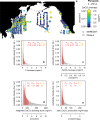Pelagic calcium carbonate production and shallow dissolution in the North Pacific Ocean
- PMID: 36808154
- PMCID: PMC9941586
- DOI: 10.1038/s41467-023-36177-w
Pelagic calcium carbonate production and shallow dissolution in the North Pacific Ocean
Abstract
Planktonic calcifying organisms play a key role in regulating ocean carbonate chemistry and atmospheric CO2. Surprisingly, references to the absolute and relative contribution of these organisms to calcium carbonate production are lacking. Here we report quantification of pelagic calcium carbonate production in the North Pacific, providing new insights on the contribution of the three main planktonic calcifying groups. Our results show that coccolithophores dominate the living calcium carbonate (CaCO3) standing stock, with coccolithophore calcite comprising ~90% of total CaCO3 production, and pteropods and foraminifera playing a secondary role. We show that pelagic CaCO3 production is higher than the sinking flux of CaCO3 at 150 and 200 m at ocean stations ALOHA and PAPA, implying that a large portion of pelagic calcium carbonate is remineralised within the photic zone; this extensive shallow dissolution explains the apparent discrepancy between previous estimates of CaCO3 production derived from satellite observations/biogeochemical modeling versus estimates from shallow sediment traps. We suggest future changes in the CaCO3 cycle and its impact on atmospheric CO2 will largely depend on how the poorly-understood processes that determine whether CaCO3 is remineralised in the photic zone or exported to depth respond to anthropogenic warming and acidification.
© 2023. The Author(s).
Conflict of interest statement
The authors declare no competing interests.
Figures





References
-
- Broecker, W. S. & Peng, T.-H. Tracers in the Sea. 690 (Lamont-Doherty Geological Observatory, Columbia University, 1982).
-
- Morse, J. W. & Mackenzie, F. T. Geochemistry of sedimentary carbonates. (Elsevier, 1990).
-
- Ridgwell A, Zeebe RE. The role of the global carbonate cycle in the regulation and evolution of the Earth system. Earth Planet. Sci. Lett. 2005;234:299–315. doi: 10.1016/j.epsl.2005.03.006. - DOI
-
- Ziveri P, de Bernardi B, Baumann K-H, Stoll HM, Mortyn PG. Sinking of coccolith carbonate and potential contribution to organic carbon ballasting in the deep ocean. Deep Sea Res. Part II: Topical Stud. Oceanogr. 2007;54:659–675. doi: 10.1016/j.dsr2.2007.01.006. - DOI
-
- Salter I, et al. Carbonate counter pump stimulated by natural iron fertilization in the Polar Frontal Zone. Nat. Geosci. 2014;7:885–889. doi: 10.1038/ngeo2285. - DOI
Grants and funding
- #2017 SGR-1588/Generalitat de Catalunya (Government of Catalonia)
- PID2020-113526RB-I00/Ministerio de Economía y Competitividad (Ministry of Economy and Competitiveness)
- CEX2019-000940-M/Ministerio de Economía, Industria y Competitividad, Gobierno de España (Ministerio de Economía, Industria y Competitividad)
- NE/N011716/1/RCUK | Natural Environment Research Council (NERC)
- OCE1220600/NSF | Directorate for Geosciences (GEO)
LinkOut - more resources
Full Text Sources

